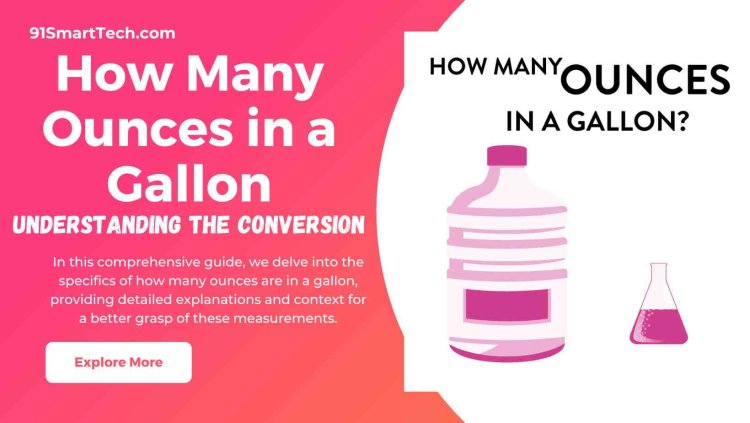How Many Ounces in a Gallon: Understanding the Conversion
In this comprehensive guide, we delve into the specifics of how many ounces are in a gallon, providing detailed explanations and context for a better grasp of these measurements.

Understanding conversions between different units of measurement is crucial, especially in the culinary, scientific, and industrial fields. Among the most common queries is the conversion between ounces and gallons. In this comprehensive guide, we delve into the specifics of how many ounces are in a gallon, providing detailed explanations and context for a better grasp of these measurements.
Also Read: Unraveling the Mystery: Why Dogs Love to Join You in the...
The Basics of Gallon and Ounce Measurements
Before diving into the specifics of the conversion, it's essential to understand what gallons and ounces represent.
What Is a Gallon?
A gallon is a unit of volume primarily used in the United States for measuring liquids. The gallon is subdivided into smaller units, such as quarts, pints, and cups. There are two types of gallons in use today:
- U.S. Liquid Gallon: Commonly used in the United States, it is defined as 231 cubic inches or approximately 3.785 liters.
- Imperial Gallon: Used in the United Kingdom and some Commonwealth countries, it equals approximately 4.546 liters.
What Is an Ounce?
An ounce is a smaller unit of volume. It is used to measure both liquid and dry substances. Similar to gallons, there are different types of ounces:
- Fluid Ounce (fl oz): Used to measure the volume of liquids.
- Dry Ounce: Used to measure the weight of dry ingredients.
For this article, we will focus on the fluid ounce, which is commonly used in volume conversions.
Conversion Factors: Ounces to Gallons
U.S. Liquid Gallon to Fluid Ounces
In the United States, the standard conversion is as follows:
- 1 U.S. liquid gallon = 128 U.S. fluid ounces
Imperial Gallon to Fluid Ounces
In the United Kingdom and other countries using the Imperial system, the conversion differs:
- 1 Imperial gallon = 160 Imperial fluid ounces
Comparison Between U.S. and Imperial Systems
It's important to note the difference in volume between the U.S. and Imperial systems:
- 1 U.S. fluid ounce = approximately 0.96 Imperial fluid ounces
- 1 Imperial fluid ounce = approximately 1.04 U.S. fluid ounces
Practical Applications and Examples
Everyday Use
Knowing how many ounces are in a gallon is practical for daily tasks such as cooking, filling up your car with gasoline, or even determining the amount of water needed for gardening. For instance, a recipe may require 2 gallons of broth. Understanding that this equates to 256 U.S. fluid ounces helps in accurate measurement and preparation.
Industrial and Scientific Applications
In industries such as pharmaceuticals, chemistry, and manufacturing, precise measurements are crucial. Converting gallons to ounces ensures accurate formulation and quality control. For example, a laboratory might need 5 gallons of a chemical solution. Converting this to ounces (640 U.S. fluid ounces) guarantees the correct amount is utilized.
Also Read: What is HTML | HTML Full Form | What is HTML Used For |...
Step-by-Step Conversion Process
Manual Conversion
To manually convert gallons to ounces, multiply the number of gallons by the conversion factor:
For U.S. Liquid Gallons:
For Imperial Gallons:
Using Conversion Tools
Online conversion tools and calculators are available for quick and accurate conversions. Simply input the number of gallons, select the desired unit (U.S. or Imperial), and the tool provides the equivalent in ounces.
Historical Context and Evolution of Measurements
Origins of the Gallon
The gallon originated in England as a measure of wine and beer, with different gallons used for various liquids. The Winchester gallon was used for dry grain, while the wine gallon was a measure for liquids. Over time, standardization led to the establishment of the U.S. gallon and the Imperial gallon, each serving distinct regions and purposes.
Development of the Ounce
The ounce has roots in the Roman uncia, a unit for both length and mass. The fluid ounce developed separately to measure volume, evolving alongside the gallon to become an essential unit in modern measurement systems.
Converting Between Different Systems
U.S. Gallons to Imperial Gallons
Converting U.S. gallons to Imperial gallons requires understanding their volumetric differences:
- 1 U.S. gallon ≈ 0.832674 Imperial gallons
To convert:
Imperial Gallons to U.S. Gallons
Conversely:
- 1 Imperial gallon ≈ 1.20095 U.S. gallons
To convert:
Also Read: How to Reach My First 5K Followers on YouTube
Common Misconceptions and Clarifications
Dry vs. Fluid Ounces
A common mistake is confusing fluid ounces with dry ounces. While both measure different types of quantities (volume vs. weight), they are not interchangeable. Always ensure you are using the correct type of ounce for your conversions.
Regional Differences
Understanding the regional differences in measurement systems is crucial. Using the wrong gallon type (U.S. vs. Imperial) can lead to significant errors in recipes, industrial formulations, and scientific experiments.
Conclusion
Grasping the conversion between ounces and gallons is vital for accuracy in various fields. By knowing that there are 128 U.S. fluid ounces in a U.S. gallon and 160 Imperial fluid ounces in an Imperial gallon, you can ensure precise measurements in both everyday tasks and specialized applications. Whether you are cooking, conducting scientific research, or managing industrial processes, this knowledge empowers you to perform accurate and efficient conversions.

 Mike2051
Mike2051 








